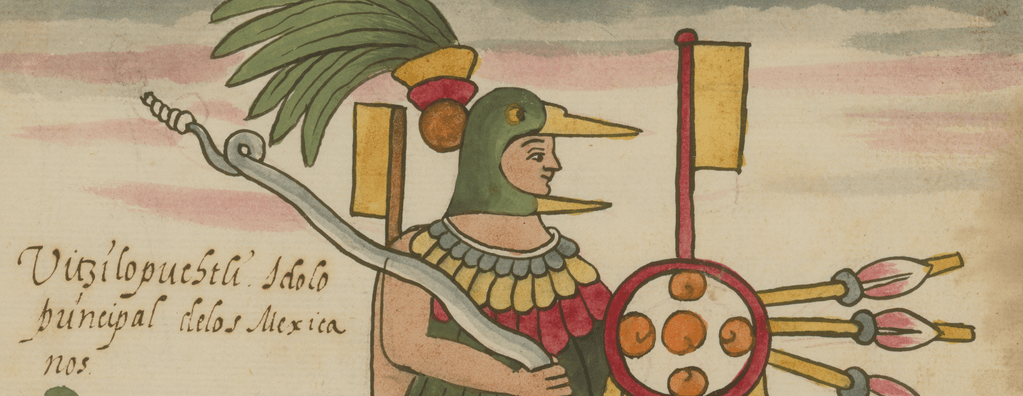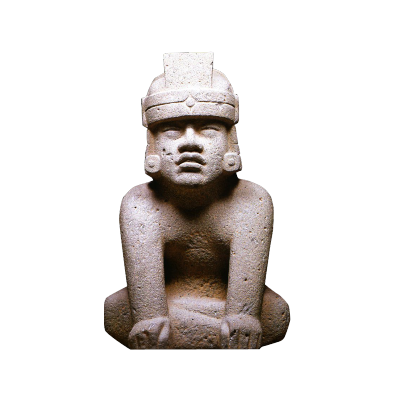
The Gods of Ancient Mexico: A Guide for Kids
The past is the origin of who we are today, and children deserve to know that magnificent universe.

Blood, war, skeletons, omens of disaster, water, stars, flowers, and ancient songs; to speak of the Mexican cosmogony is no easy task. It implies entry into an exalted, colorful, magical universe, rich in shadow and light. How does one approach it with little ones? Beyond a question of identity, any approach to pre-Hispanic mythology detonates a curiosity for the different, amazement before the tremendous, an acceptance of our dark sides, and of a past that makes the Mexico of today into what it is.
For example, to gaze into the snake skirts of the Coatlicue is to go deep into the earth, as when in childhood we splashed in the rain and stuck our elbows into the mud. To allow oneself to feel the tenderness inspired by Huehuetéotl, the bent old man, is as important as snuggling into a grandmother’s song. Laughing with Itzamná, a toothless old Maya with pronounced cheekbones above sunken jowls, or at Ah Mun, a Maya god from whose head grew a corn stalk, is as essential a skill as learning to laugh at oneself.
The following exercise is easy and an invitation to fun. Just go to a museum, open a book, or go for a walk while looking closely at all the fantastic forms. With such forms, the inhabitants of these same lands, many centuries ago, tried to represent their own wildest dreams.
Gods for Kids
Imagine a mirror that doesn’t return the light, but the shadows. Imagine a volcano that spits lava as black as night. Thus was Tezcatlipoca, the smoking mirror. He was believed to be omnipresent and omnipotent; he was everywhere and could do anything. His character was very complex, volatile, and capricious: a god who thought like a cat, a cat-made deity. Tezcatlipoca gave, but he also took things away. Due to his ever-changing nature, he could bring illness and trouble. Many names and images have been associated with him, but his unmistakable symbol is two mirrors, one in his hand and another on his foot, from which smoke emerges.
We all know that Quetzalcoatl means the feathered serpent. He’s the most famous god of the Anahuac culture. He embodied life, light, fertility, and knowledge. He was the shining opposite of his brother, Tezcatlipoca. While Quetzalcoatl was associated with the morning star, Tezcatlipoca was associated with the evening star. But the star is one and the same planet: Venus. The important lesson is that the eternal fights between the two brothers were but the changing faces of reality, a play of opposites giving identity to being.
The Legend of the Five Suns
This idea is perfectly reflected in the Legend of the Five Suns. Anthropologist and historian Miguel León Portilla once argued that this very legend formed the basis of the thinking and regulated the practices of the ancient inhabitants of the Valley of Mexico. The Nahua people postulated four ages prior to their own, each with a corresponding sun, color, course, and food. Each was then destroyed by a different element. Records are incomplete and versions diverge, but a summary of the legend can be relayed as follows:
First Tezcatlipoca, the black-headed god, became the sun of the earth to give light to the giants who ate pine nuts. Quetzalcoatl slayed him with a single blow, the sun broke over the earth, and tigers devoured the giants. Then Quetzalcoatl, the white-headed god, became a wind-sun to light the people who ate mesquite. Tezcatlipoca brought down this sun with his tiger claw. The sun melted into the wind and transformed the people into monkeys. Tezcatlipoca took advantage to make Tlacatecuhtli from the red. This was a sun of fire to illuminate the people who ate a seed-like corn. But Quetzalcoatl brought down that sun with a single blow. It burned until the people became birds. Finally, Quetzalcoatl made Chalchiuhtlicue from the blue. It was a water sun to give light to the people who ate a wheat that sprouts in water. But Tezcatlipoca brought this sun down with his tiger claw. The sun drowned, and the people became fish. As there was no one left, Quetzalcoatl descended to the underworld. There he breathed life into the bones of the people, and the gods decided to light a fifth sun with their own sacrifice. Thus arose Nahui Ollin, a green sun of movement to illuminate the people who eat corn. Someday Tezcatlipoca will steal this sun and the world will end in tremors and hunger.
Children can be taught that the succession of foods as they appear in the myth may well represent the evolution of human food. In the beginning, the corn that people eat today didn’t exist. It was the result of selection and cultivation, over many centuries. This changed a thin grass into the nourishing and tasty sustenance we find on our dinner tables today.
So why speak of the gods of ancient Mexico to children? The answer is simple: because we want to speak to children about the universe, the world they inhabit, and the territory in which they dwell. In the cosmogony of our ancestors, we find the same drama of creative and destructive forces in the galaxies over our heads and the emotions inside our bodies. In other words, we present this complex imaginary world, filled with life and color, because we want to make them complex and sensitive subjects who appreciate the many stories of which we’re all made.
